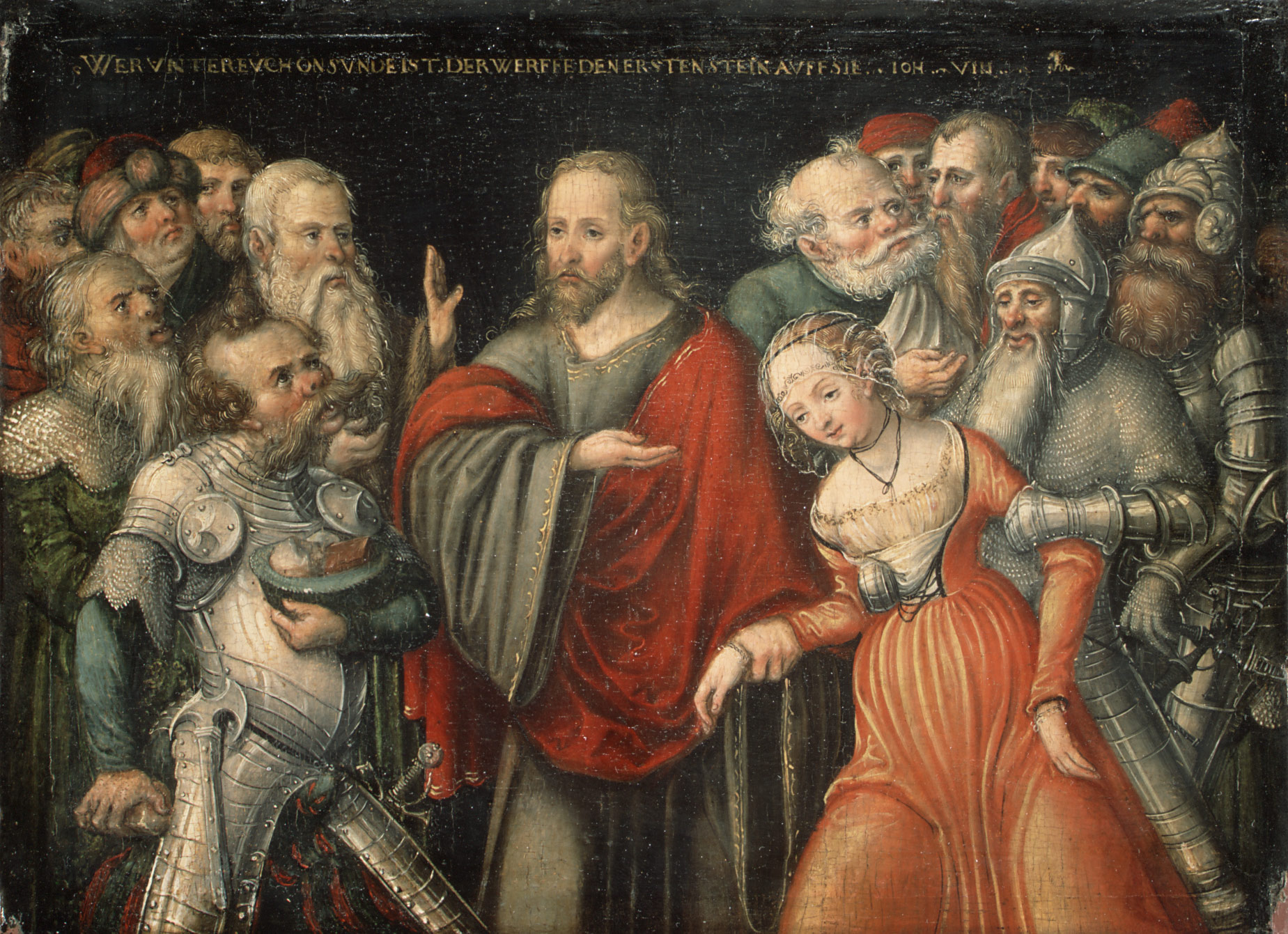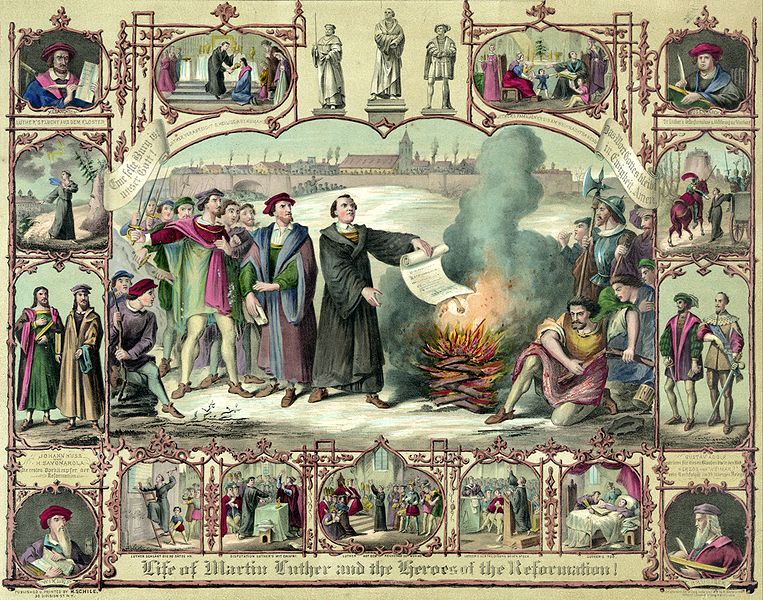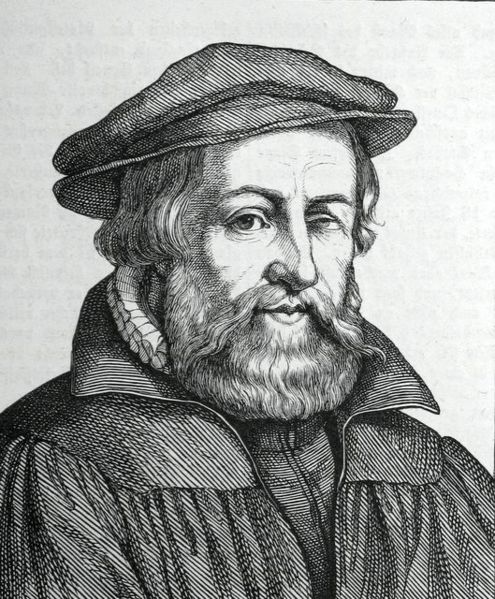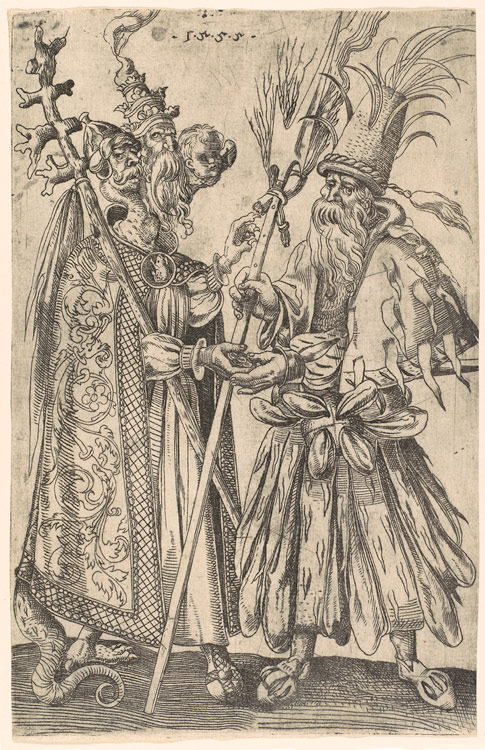Reforming History
How the Reformation Altered the Purpose and Goal of History
Reformation historiography largely centered around the revision of history, removing the elites as the sole makers and consumers of history. Further, this meant movement away from histories that centered around Rome and reinforced the authority of the Catholic church. Additionally, Protestant historians were attempting to write their religion into history and provide Protestantism with authority through origin stories. However, in the end, the Reformation became the catalyst for secular history and the professionalization of history as a profession.

The Reformation
The Reformation was a movement away from the Roman Catholic Church, which caused a deep distrust in the church. This distrust came from years of grievances with the Catholic Church, largely revolving around access to information and corruption. Martin Luther (1483-1546) and his 95 Theses are often cited as the beginning of the Reformation. In 1517 Luther was prompted to write his 95 Theses because of practices in the Catholic Church such as the purchasing of indulgences. He saw these practices as a sign of the deep corruption within the church. Luther’s basic premise, which was one of the fundamental pieces of Reformation ideology, was “every man a priest,” essentially meaning that the established hierarchy in the church was not necessary. In fact, the hierarchy of the Catholic church was seen as inherently wrong. According to Catholic doctrine, individuals must go through a priest to talk to God; however the Reformation stood for the proposition that every man could talk to God without a middle man. This undermined the hierarchy of the church and by extension the hierarchy of the state. During this time the two entities were deeply intertwined while also competing for superior authority. Such a dual construction of society can be visualized by the Gelasian concept of the “two swords.” Essentially, the idea was that there were “two swords,” the church and state, which competed for superior authority said competition ultimately shaped Europe. Both were also strict hierarchies, and as such calling into question the hierarchy of one would be to question the hierarchy of both. In this way, the Protestant Reformation challenged the authority of both the church and the state.
Origins and Agendas in the Reformation and Their Impact
The period from 1515 to 1525 was perhaps one of the most innovative times in European history, as well as one of the most controversial (Grant, 89). This was an era featuring momentous impacts on the Western world, religiously, politically, and historically; the Reformation began to take hold during this time and shift the focus of the population (Spitz, 1). The origins during the Reformation differ greatly from earlier eras in that there was a distinct departure from Roman roots as the source of legitimization, and the “barbarian” societies began to look inward to their own traditions in an attempt to establish identity, meaning, and a place in history. Perhaps this departure marks a “progression of empires”–empires that are constantly changing throughout history but at the same time building upon previous era’s traditions and ideals.

This departure or progression highlights the importance of agenda to historiography in the Reformation. In the early 16th century, and before, citizens exclusively accepted the teachings of the Catholic Church (Wiesner-Hanks, 255). However as the Reformation began, many reformers observed the teachings and practices of the Church and began preaching against the greed and corruption they witnessed. Separating from previous eras, the agenda of many historians during the Reformation began to separate into two-parts. There was the Catholic Church and other religious institutions, which still remained very powerful. Pushing up against the Catholic Church was a strong movement towards a more secular agenda. This duality of the spiritual and the secular caused two distinct narratives to dominate the Reformation. These two narratives, while not altogether groundbreaking, were a new way for history to be approached as a profession. These narratives were also caused, in part, by a polemical view of “tradition” and in many ways—by extension—the church; there was a general separation from the Roman Catholic Church during this period and the emergence of the new Protestant segment headed, in large part, by Martin Luther (1483-1546), a 16th Century theologian and professor of theology at Wittenberg University in Germany (the university has since been renamed in honor of Martin Luther), who challenged the authority of the Pope and Roman Catholic Church (Wiesner-Hanks, 255). Luther, born into a middle-class peasant family, received his education, in part, at the University of Erfurt, where he studied law at a university renowned “for its humanism, and various religious tendencies fermented there,” (Grant, 98). Luther’s reformation was, in part, hastened by the selling of indulgences (clemency of sins) by powerful Popes, such as Leo X (Spitz, 65-67). One of Luther’s greatest and most impactful contributions was his undertaking of making the Bible more accessible to the people by translating it from Latin to vernacular, in part helped by the advent of the printing press. These translations, translated not from Hebrew or Greek, were translated from a late fourth-century Latin version of the Bible known as The Vulgate into fourteen translations (Grant, 96). Luther’s view of history was highly spiritual - he believed that the Bible was the only true source of salvation, a direct contradiction to the powerful Roman Catholic Church, which sought authority and legitimacy from the Bible. This religious schism caused divisive shockwaves throughout Germany and the world at large; the region of Germany splintered along religious lines and the world, as a whole, experienced the effects of this religious reformation (Grant, 179). Religion, politics, and history had traditionally been closely interconnected and Luther also marked an important change from a focus on the past and prior traditions, to new attention being paid to the idea of modernity–impacting the course of history. (Wiesner-Hanks, 256-260). Luther, opening the possibilities of other legitimized religions created an atmosphere of tolerance, which in turn opened up the possibilities for growth and innovation in the fields of science, philosophy, technology and history (Wiesner-Hanks, 264). 
</figure> Martin Luther, along with others such as Johann Sleidan, represented a changing of the tides in historiographical terms. Johann Sleidan was a 16th century Humanist with a law degree, hired as the official historiographer of Germany. Sleidan, leaning on his legal background, adhered to the practice of placing value in first–hand witness accounts–a practice first established by Thucydides. Sleidan looked to these accounts in an attempt to vicariously experience the past (Kelley, 167). Sleidan was so staunchly attached to evidence that he famously said, “I would rather die than say, still less write, anything without proof”(Kelley, 169). This was not necessarily new - - perhaps the zealous adherence was - - but marked a change in the way professional historians approached their practice.
Revisionism in the Reformation
The ultimate effect of the Reformation on historiography marked a “massive project of revisionism, which proposed, first implicitly and then explicitly, to rewrite universal history so that it would convict the Roman hierarchy and justify the ‘true religion’ ” (Kelley, 167). Prior to the Reformation, the hierarchy established by both the Church and state was the foundation of all histories. Histories were written by and for the elite. All histories lead back to Rome and justified the Roman Catholic Church. The Reformation’s fundamental goal was to undermine and convict the long standing tradition of Roman and Catholic centered histories. In part, this was accomplished by historians, such as Johann Sledian, who were vehemently dedicated to impartiality. Sleidan was hired by the German princes to be the historiographer of the Reformation. His job was to discuss Luther, in addition to the agenda and efforts of the Protestant party. Sleidan personally felt convicted to recount a fair and equal telling of history. A French historian by the name of Commynes wrote histories in which it was said that “in no way did he praise those of his own country or race, even kings who had raised him to high honor, unless it was true…, [and] everywhere he presented the facts in themselves,” (Strasbourg, 1548). Sleidan sought to write these kinds of histories, histories in which he didn’t praise any particular person or event because of a personal connection. By writing impartial histories, for the first time, the Church and state were potentially exposed to negative work. This allowed for the introduction of histories that didn’t center around the long standing elites.

Challenging Tradition
An extension of the revisionism that occurred during the Reformation was a distrust for tradition, which became the grounds to criticize the Catholic church. Such distrust was expressed by Dante, who stated that “those who rely solely on the tradition, therefore, must be thrown out of the arena” (Alighieri, 56). Everything within the Church operated based off of known traditions that had been around for generations– these traditions maintained the hierarchy and shaped histories. Because most individuals were illiterate, histories were for the very elite in society such as the upper-class and clergy. Inevitably the intended audience generated histories that fit the elite’s perception of the world. The heaving influence of tradition on history, therefore was utilized to criticize not only the Pope but also the ecumenical council which was the chief rival to the pope’s authority. Further, the conflict between the Pope and council represented a tear in the Catholic Church itself. The council represented another Catholic tradition, which according to Reformation writers created a kind of faction within the Catholic Church between the Pope and the council. This faction represented the consequences of following tradition: discord that leads to failure.
The Conflict with Human Traditions
Another facet of tradition in Reformation history was human traditions. Protestant history became a conflict between “spirit and letter.” That is to say, history as the process of God’s Word and history as the product of human’s sin. History was, therefore, often seen by Protestant historians as the degradation of the church. However, historians in the strain of Johann Sleidan were more concerned with the “truth.” He once said that “Candor and truth are the two most becoming ornaments of a history” (Kass, 91). While he was devoutly committed to the Reformation, he also felt that political history played an important role in religious history. Both human history and God’s history were intimately connected and with-out one the other couldn’t be fully explained. In Sleidan’s book The General History of the Reformation of the Church, Sleidan stated that “in the history of religion, I would not omit what concerned the civil government because they are interwoven with the other.” In other words, religious history is a product of its time, and to omit civil history is to omit part of what created religious history. To report one or the other would be simply reporting only half of what happened. The conflict between God’s history and human history will come into play later as Protestants try to construct their origins.
Sleidan’s commitment to recounting both religious and civil history speaks to what he believed was historical “truth.” As stated, Sleidan believed that neither religious or civic history were complete without the other. Later in his life, Sleidan wrote a friend asserting, “I would rather die than say, still less write, anything without proof” (Kelley, 169). Here, religious history, according to Sleidan, was the history of human sin, not the process of God’s Word. Truth was unbiased in Sleidan’s view. His dedication to the truth and impartial histories inevitably effected the way he wrote as he dealt with a changing society that exhibited a great deal of religious dissent. For Sleidan, “truth” came from original sources and eyewitness accounts. The belief that these two sources best reflected the truth appears to be a widely held conviction. However, eyewitness accounts–at least for Sleidan–came from only himself or trusted peers (Kass, 91-93).
Finding Protestant Origins
As the Reformation began, Protestants had to construct their histories and origins. While it may seem obvious to say that Protestant history began with the Reformation, Protestant historians of the time would disagree. Protestants traced their history back to the ancient times. One such writer, John Foxe, stated that, “we have the old actes and histories of auncient tyme to give testimonie with us…, to declare the same form, usage, and institution of this our Church reformed now, not to be the begynnyng of any new Churche of our owne, but to be the renewiyng of the old auncient Church of Christ.” The notion that the Protestant church was simply the resurgence of a church that existed in ancient times became the manner in which Reformation histories legitimized Protestantism as the “true religion.” Martyrs also became a part of the rhetoric involving Protestant origins.In part, the purpose of this was to show the deep roots of the Protestant faith, however there is a certain amount of accusation that accompanies the martyr argument. Without really saying it, Protestant histories were saying that Catholics had been persecuting the “true religion” the whole time. Essentially the goal of Protestant history was to establish origins that legitimize the Protestant faith, while simultaneously devaluing the Catholic faith. Protestant historians wanted to establish their religion as the ultimate source of truth.
Duality in the Reformation
Throughout the Reformation, history was looked at through a critical lens and occupied a polemical role (p163, Kelley). While insistently critical, historians–as a profession–were regarded with much higher esteem than previous eras. Often this higher regard was used in attempts to link history to various agendas - Protestants attempted to link their own traditions to that of older traditions. This distinct duality present during the Reformation, and distinct from earlier eras, allowed for two completely separate narratives to emerge (Kelley, 163). Coupled with this duality, there was a complete collapse of the religiously centered national identity and further emphasis placed on national narratives to build the identity of the people.
The idea of “Confessional History” emerges out of the Reformation and, “in many ways pluralized, politicized, and polemicized, subverting the master narrative of Christian universal history.” (Kelley, 169) Hastened by the controversies initiated by Martin Luther, a large scale, deep investigation into the sources used by medieval and early Christian historians began. The views of history during the Reformation, and even the Counter-Reformation, are formulated through a combination of chronological and geographical frameworks along with the ideals of a universal history codified from the medieval chronicles (Kelley, 170). The Protestant theologians saw this “confessional history” through a moral rather than political lens. Protestants also faced the problem of plotting a meaningful tradition and constructing a communal history in a new way. This was approached in two ways, the first of which was the Melanchthon method, which sought a doctrinal continuity by tracing a spiritual tradition based on “pure religion” back to the early fathers of history. Competing with this method, started by 16th century humanist and Lutheran, Flacius Illyricus, was the belief that legitimization and credibility came from the idea that there was a continuous holy succession of the Christian doctrine, which preserved the true Christian faith. Illyricus complied hundreds of names of the precursors of the Lutheran faith in this effort to prove a rich historical tradition (Kelley, 171). This idea of history providing a cornerstone for legitimization and confessional correctness became pivotal during the many religious controversies that took place during the Reformation (Kelley, 172).
The idea of universal history was codified as a distinct narrative during the Reformation allowed a broadening of accessibility to said history. The idea of universal history, during the Protestant Reformation, is one marked by an incredible revisionist effort to rewrite history in such a way that it “would convict the Roman hierarchy and justify the ‘true religion’, which Luther and his colleagues were preaching.” (Kelley, 167). Often national historiographers generated or invented “traditions to suit modern needs and hopes,” as well as to serve as a source of credibility (Kelley, 168). As a result, most nations developed their own “versions” of a universal history uniquely suited to the context of their country; while these histories and traditions varied slightly in content, they were uniform in their goal of providing credibility, sense of individualism, as well as establishing a place in the history of the world.
Alongside confessional and universal histories, another history that had emerged in earlier eras but really began to take foot in the Reformation was humanism. In the process, humanism placed a further focus on looking at individual histories and the importance of humans in and on history. This was a time for immense growth in both the field of historiography, and in the potential for history to become a respected science rather than mere art, “yet the rhetoric of historical impartiality, disinterested curiosity, and scientific aspirations remained; and even the most committed historians contributed, if only inadvertently, to the project of historical inquiry–to tell the truth, be humanly useful, and perhaps even be a way to wisdom. ”Clinging to these ideals–and at the same time vastly increasing the quantity, accessibility, and critical understanding of source materials–history reinforced its potential to become a true science.” (Kelley, 187)
Works Cited
Alighieri, Dante. On World-government; Or, De Monarchia. New York: Liberal Arts Press, 1949.
Grant, A. J. A History of Europe from 1494 to 1610. New York: n.p., 1951. Print.
Kelley, Donald R. Faces of History: Historical Inquiry from Herodotus to Herder. New Haven: Yale University Press, 1998.
Kess, Alexandra. Johann Sleidan and the Protestant Vision of History. Aldershot, England: Ashgate Pub., 2008.
Lucas Cranach the Younger and Workshop . Christ and the Adultress. Ca. 1545-50. The Met. http://www.metmuseum.org/toah/works-of-art/1982.60.35/
Lorck, Melchior . Satire on the Papacy. 1555. The Met. http://www.metmuseum.org/toah/works-of-art/53.677.5/
P. Comminaei de Carlo Octavo (Strasbourg, 1548); Eng. trans., “The Epistle of John Sleidan” to the Protector Somerset.
Preface to the English translation, The General Hisotry of the Reformation of the Church (London, 1689); VH.
Spitz, Lewis William. The Protestant Reformation, 1517-1559. New York: Harper & Row, 1985. Print.
Tertullian, Apology 50.13.
The First Volume of the Ecclesiasticall Hisotry (London, 1576), 2; VH.
Wiesner, Merry E. A Concise History of the World. New York: Cambridge UP, 2015. Print.